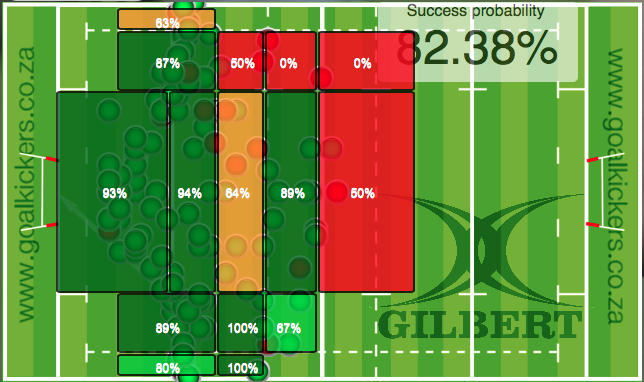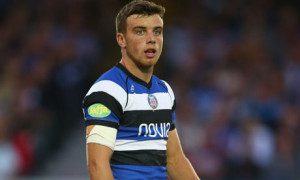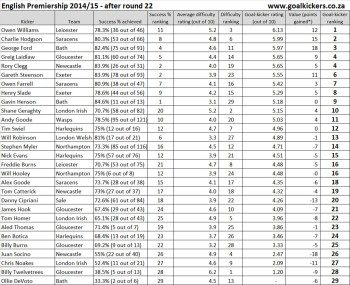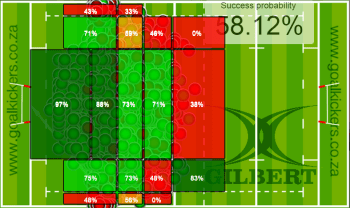
PHILADELPHIA, PA – Here it is: the final kickers ranking table for the 2014-2015 regular season of the Aviva Premiership!
The Most Valuable Kicker (MVK) is George Ford with 18 points scored over the expected return.

Ford finished the season well, and continued to add value to Bath right through the end. Gareth Steenson and Rory Clegg have the best straight percentage except for Gavin Henson, who has a small sample size and did not finish the season in the league. However, with both percentage and difficulty considered, Clegg is tied for 4th and Steenson finishes 6th.
First, just the top of the table:


*These rankings and other graphics can be found on Goalkickers.
Straight percentage is not the best measure, but neither is points scored. As outlined earlier, the top points scorers are simply the guys who get the most chances. They aren’t necessarily the best kickers. Andy Goode’s Golden Boot-winning performance was actually close to average. Comparing kickers on percentage alone ignores differences in difficulty. That’s bad.
The title of League’s Sniper, the man with keen aim from long range, could go to a few kickers. Eliot Daly, Wasps, only had 4 chances, but he made 3 and they were all 50+ meters in distance. Henry Slade was 9 from 14 from a distance of 45+ meters. The kicker with the best ranking overall (6.13 out of 10), Owen Williams, was 12 from 17 from similar range before he was hurt. With a few more chances (in an injury-shortened season) and a better strike rate than Slade, Williams is the League’s Sniper.
League-Wide Performance
To see how all of the league’s kickers performed through the 22 rounds, here is the Heatmap which shows the rates of success from different areas of the field.

Team Performance
In terms of team performance, the best kicking side is Exeter. Steenson and Slade were a strong combination of range and accuracy. Their numbers would be even better if not for a couple pretty shocking misses. For the season, the Chiefs kicked at 82% overall – 80% for conversions and 84% for penalties.
Here is a table comparing the performances of all sides. London Welsh are at the bottom in terms of straight percentage even though their kickers had the easiest pool of kicks.
| Team | Penalty Attempts | % Penalties | Con. Attempts | % Con. | Total Chances | Total % |
| Exeter | 79 | 84% | 70 | 80% | 149 | 82% |
| Wasps | 66 | 85% | 77 | 75% | 143 | 80% |
| Saracens | 85 | 79% | 71 | 79% | 156 | 79% |
| Bath | 65 | 74% | 72 | 78% | 137 | 76% |
| Harlequins | 65 | 78% | 45 | 69% | 110 | 75% |
| Leicester | 92 | 79% | 37 | 62% | 129 | 74% |
| N’Hampton | 60 | 80% | 75 | 69% | 135 | 74% |
| Gloucester | 96 | 71% | 53 | 74% | 149 | 72% |
| Newcastle | 52 | 77% | 57 | 61% | 109 | 69% |
| Sale | 49 | 71% | 62 | 66% | 111 | 68% |
| London Irish | 72 | 68% | 46 | 67% | 118 | 68% |
| London Welsh | 23 | 52% | 29 | 72% | 52 | 63% |
For the season, for all teams, 72% of tries were converted. 77% of penalties attempted were made.
This spread isn’t surprising. Given that teams have control over which penalties to kick but limited control over where a conversion is taken, one would expect the lower rate of success from conversions.
The difference in the rate of success is bigger for kicks out wide. Kicks taken from between the touchline and the 15 meter hash are successful 60% of the time overall. The rate for conversions was 55%, but the rate for penalties was 66%. That means that, in general, teams with average or below average kickers adjust their decision making accordingly. Teams with better kickers let their kickers take more difficult penalty attempts. It seem perhaps obvious, but it is still evidence that teams with average and below average kickers need to opt for the lineout more often. The lack of the full range of decisions necessarily hampers a team.
One team that was so good this season that their below-average kicker did not interfere with success was Northampton. Stephen Myler cost the Saints 7 points over the course of the season. His percentage of 73.3% is in the range of “common sense acceptable,” but his kicker rating was 4.710, with 5 being the rating for an average professional kicker. Despite the fact that his performance was below average and he was the 14th best kicker overall, he still scored 212 points from the tee, second in the league.
His relative weakness did not slow the Saints down, but it did mean that they had to opt for the line out often when winning penalties in their attacking half.
Here is something odd:
This season also offers more evidence that the left side of the field is better for right-footed kickers. Curiously, though, the left side of the field was also the better side for left-footed kickers. One season’s data is not enough to prove or disprove conventional wisdom, but here is what it shows.
| Left side of field | Right side of field | |
| Right-footed kickers | 75% | 72% |
| Left-footed kickers | 70% | 61% |
The validity of this conventional wisdom seems to be something that is still open for more investigation.
The Recap’s Recap
Looking ahead to the weekend, if the playoffs are about the kickers, Saracens have the edge with both Charlie Hodgson and Owen Farrell as Top Ten options.
It also seems to make sense to acknowledge the other end of the spectrum: the kicker who makes fans and foe alike simply grimace. He is Mr. Cringe. This year, that title belongs to Newcastle’s Juan Socino who cost his team 18 points.
MVK: George Ford
Sniper: Owen Williams
Mr. Cringe: Juan Socino
To review other updates from earlier in the season, check here and here.
In true kicker fashion, the physical awards must be visualized before they actually exist. I will be following up soon with a reflection on the process of collecting this data and what area of the game is to be dissected next. In the meantime, have fun clicking through Goalkickers and let the questions fly!
That’s it for now. Feel free to add your thoughts below, please look for and “Like” our Facebook Rugby Wrap Up Page and follow us on Twitter@: RugbyWrapUp, Jake Frechette, Junoir Blaber, James Harrington, Jamie Wall, Nick Hall, DJ Eberle, Scheenagh Harrington, Jamie Loyd, Cody Kuxmann, Karen Ritter, Audrey Youn, Akweley Okine and Declan Yeats, respectively.

